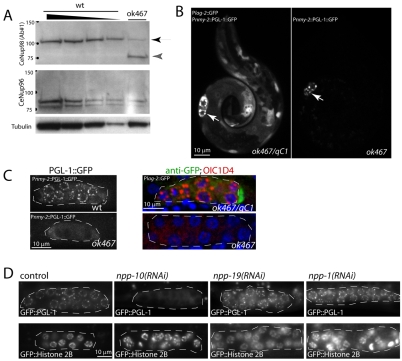Fig. 4.
CeNup98 is required for P granule integrity in larvae. (A) Western blot of wild-type and ok467 C. elegans larvae extracts probed with anti-CeNup98, anti-CeNup96 and anti-tubulin (loading control) antibodies. Black arrowhead points to full-length CeNup98 and gray arrowhead points to the CeNup98 truncation product. Low levels of full-length CeNup98 are detected in the ok467 extract, which is likely to be maternal CeNup98. The CeNup96 antibody recognizes a doublet; both bands are eliminated by npp-10(RNAi) (Galy et al., 2003). (B) Fluorescence micrographs of an ok467/qC1 L1 larva (expressing lag-2::GFP in several somatic cells) and an ok467/ok467 L1 larva (lacking the lag-2::GFP-marked qC1 balancer). Both show the wild-type PGL-1::GFP pattern in the two primordial germ cells (arrow). (C) Fluorescence micrographs of L2 gonads of the indicated genotypes expressing PGL-1::GFP, or stained with anti-GFP antibody (green; denoting the presence of the qC1 balancer) and OIC1D4 antibody (red; P granules). (D) Fluorescence micrographs of live L2-stage gonads expressing GFP::PGL-1 or GFP::Histone H2B (to highlight nuclei). RNAi treatments were applied by feeding starting at the L1 stage. Note that only npp-10(RNAi) disrupts GFP::PGL-1.

